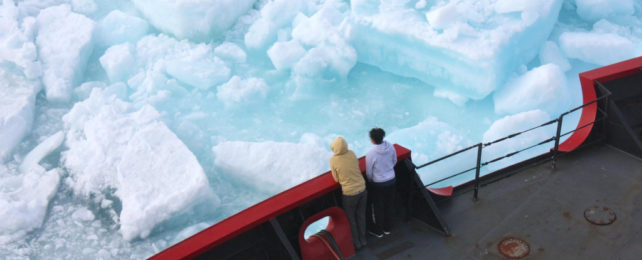Researchers have rebuffed a wild idea to use tiny, hollow glass beads to halt sea ice loss, finding that a coating of microspheres would actually accelerate ice melt instead of slowing it.
In 2018, a study proposed spraying layers of glass powder, in the form of hollow glass spheres about the thickness of a human hair, over Arctic sea ice to brighten its surface.
This, the study authors said, would enhance the amount of sunlight reflected in a part of the world that is seeing some of the worst effects of climate change, lowering the surface temperature and giving sea ice a chance to recover.
Satellite data shows sea ice in the Arctic is "melting at a frightening rate". Simulations suggest it could be completely gone in Arctic summers by 2050. But the new research puts forward a comprehensive set of calculations to show why tiny glass beads are not the answer.
"Our results show that the proposed effort to halt Arctic sea-ice loss has the opposite effect of what is intended," says Melinda Webster, a polar scientist at the University of Alaska Fairbanks Geophysical Institute. "And that is detrimental to Earth's climate and human society as a whole."
Webster teamed up with University of Washington atmospheric scientist Stephen Warren to test the claims of the 2018 modeling study, which had concluded that a layer of 65 micrometer-wide glass spheres spread about five beads deep could increase the reflectivity and thickness of Arctic sea ice.
Where the 2018 study only considered thin sea ice with little snow cover, the duo calculated changes in solar energy across eight sea ice conditions found in the Arctic at different times of the year. They modeled the same thickness and type of hollow, glass microspheres.
Unlike the previous study, they considered seasonal snow and meltwater coverage, along with sunlight at sea level and in the upper atmosphere, cloud cover, and how the beads interact with sunlight.
Layers of microspheres can make new, thin ice more reflective, as the 2018 study showed. But the effect of the glass beads would be minimal because thin ice mostly occurs in autumn and winter when there is little sunlight, Webster and Warren write.
Come spring, most Arctic sea ice is blanketed in bright-white, deep snow, which is highly reflective, so adding glass beads would actually darken sea ice surfaces at this time of year, leading to greater warming and ice loss.
"Because hollow glass microspheres absorb some sunlight, spreading them onto sea ice would darken bright surfaces such as snow-covered ice," Webster and Warren write. "The net result is the opposite of what was intended: spreading hollow glass microspheres would warm the Arctic climate and speed sea-ice loss."
Although the hollow glass microspheres reflect a large fraction of sunlight, a thin layer of beads still absorbs about 10 percent of energy from the Sun's rays – enough to hasten warming in the Arctic.
If non-absorbing glass beads could be developed, they could cool the Arctic climate – but it would take 360 million tons of hollow glass beads spread over sea ice each year, Webster and Warren found. Even if they worked in theory, manufacturing and transporting those beads is bound to spew more carbon emissions into the atmosphere.
Put simply, this is not the kind of action on climate change that we need; reducing carbon emissions is what counts. And if we're talking about restoring environments, better to focus on restoring forests, marshes, peatlands and seaweed ecosystems that can soak up considerable amounts of carbon dioxide, if done right.
In the decades we've already spent dilly-dallying about climate change, we've already lost more than half of the Arctic's permanent ice.
"The use of microspheres as a way to restore Arctic sea ice isn't feasible," Webster says. "While science should continue to explore ways to mitigate global warming, the best bet is for society to reduce the behaviors that continue to contribute to climate change."
Luckily, we already know how to do that, and the outcomes – fewer carbon emissions – are a much safer bet than gambling on incredibly risky and largely untested geoengineering strategies.
Making changes to heat-absorbing built environments by whitening rooftops and greening cities might also be a good place to start.
The new study was published in Earth's Future.
